1973 Ford Mustang
1973 Ford Mustang Overview
For historical context, by the time 1973 rolled around the Maverick was outselling the Mustang and the Mustang had become a big, boring and not at all exciting car that was far removed from its original mid-60s style and mission. The fuel crisis had also moved buyers’ preferences from large, gas-guzzling muscle cars to smaller, more fuel-efficient cars. It is no surprise then that Ford needed a change and thus the 1973 Mustang marked the end of the first generation. Due to government regulations, the 1973 Mustang would be the last Mustang convertible until 1983 and it would be the last year for Mustang Grande also. In its final year, there were a total of 134,867 Mustangs produced.
| Model: | 1973 Ford Mustang |
| Generation: | 1st Generation Mustang |
| Type: | 2 Door |
| Body Styles: | Coupe, Convertible, Fastback |
| Engines: | 250ci six, 302ci 2bbl V8, 351ci 2bbl V8, 351ci 4bbl V8, 351ci CJ 4bbl V8 |
| Original Price: | $2,760 (Basic Coupe), $3,102 (Convertible), $2,820 (Fastback) |
| Units Produced: | 134,867 |
Additional 1973 Mustang Research: 1973 Research Center / Colors Details / Production Numbers / Prices & Options / Sales Brochures / Owner Manuals / Maintenance / Pictures / Videos / VIN Decoder / Special Editions
Background & Details
1973 brought the last year of the “big” Mustang, the last of the first generation Mustangs. It was going to be replaced by a smaller, lighter Mustang and Ford was focused on getting that ready, therefore, most of the changes for 1973 were purely cosmetic. A large, square, chrome headlamp bezel appeared, as did chrome trim around the tail lights. A color keyed Urethane front bumper replaced the chrome units of the previous years. The front parking lights were now placed vertically in the front grille.
A new, grained, black applique with bright trim was placed on the rear body panel between the tail lights. This was replaced with a honeycomb style on the Mach 1 and Grande models. The 1973 Mustang convertible was to become the last Mustang convertible for many years.
This was also a year of first for Mustang It was the first year where FORD did not restyle the mustang after 2 model years, it was the first of many years to come where horsepower and performance steadily declined. It was the first to start engine cubic inches in a decline. The next generation of Mustangs known as Mustang II’s would become smaller and “broken” to use a horse term. The next performance car Ford will make will be in 20 years in 1983 when they make a GT with a Holley 4bbl carburetor. I had a 1968 coupe 302 2bbl, 1966 289 GT fastback and 1967 289 4bbl, 4-speed dark green convertible. These would remain my only mustangs until 1983 I vowed not to step backwards and buy an under performing Mustang no matter how much repair work needed to be done to keep the old ones running!
The 1973 Mustang resembled the 1971 and 1972 Mustangs very closely. In most respects, they were unchanged. The most obvious change was the redesigned grille. The egg crate mesh was larger and the turn signal lamps were located within the grille opening. Headlight location remained unchanged, however, the headlight bezels were chromed and similarly, the taillight bezels were finished in bright metal. The front bumpers were different (modified to meet the new federal crash standards), front fenders are different, grille is different. However, if you look casually at the cars, the average person will not distinguish one year from another. The grill had the turn signals mounted in the outside part of the grille.
Headlight bezels and taillight bezels were bright metal, not color coordinated or flat black. The chrome lip on the front of the hood was color keyed as were the front fender extensions, in previous years, they were mostly chrome. The standard running horse in the grille is enclosed in a a corral and has a vertical bar going up and down like the ’65 Mustang. The whole grille assembly is surrounded in a shiny chrome colored metal rectangular corral as well. The Mustang script on the front fenders remains unchanged from previous years.
Bumpers and bumper mountings were modified and the urethane front bumper became standard, and was enlarged in accordance with new NHTSA standards. The bumper was color-keyed to the car’s paint as were the hood and fender moldings. The rear bumper, similar to the 1971-72 unit, was mounted further away from the rear of the car in order to comply with the 2-1/2 mph rear standards.
Engine availability was largely unchanged from 1972. The main change was Ford no longer offering the 351 HO engine. You could get the 351 4bbl and 351 2bbl as an upgrade to the 302. Even though it was the last year for the big Mustang, some mechanical improvements did appear. Suspension travel was increased by a 1/4 inch and the standard drum brakes were larger. And all convertibles came with power front disc brakes.
The Lee Iacocca Mustang II will make its debut in “74 and thereafter for the next 4 years. Goodbye to the first generation Mustangs.
Special Edition Models & Variants
It is hard to call this list of models “special” but they technically count so we technically talk about them. The most exciting of the specials was a movie car used in the 1974 film Gone in 60 Seconds. Known as “Eleanor” the car was actually a 1971 Mustang in 1973 Mach 1 trim.
Grande
The last of the Mustang Grande models was much like the Grande cars from 1969 onward in that it was the “luxurious” Mustang. The Grande was unchanged, save for colors and vinyl roof treatments. Noticeably absent from the option list were the 15×7″ chrome Magnum 500 wheels. The 1973 Mustang Grande option was only for the hardtop and consisted of a vinyl roof, plush interior with deluxe cloth high bucket seats, electric clock, interior trim panels with molded pull handles and arm rests, deluxe two-spoke steering wheel, color-keyed racing mirrors, full wheel covers, metal rocker panel moldings, metal wheel lip trim, and dual exterior paint stripes.
Learn more about the 1973 Ford Mustang Grande
Mach 1
While there were no major differences in the ’71 and ’72 Mach 1s externally, the 1973 Mach 1 did receive some significant appearance updates. The lower body accent paint and bright trim were gone and the entire car was one color top to bottom. All ’73 Mach 1s received a wide body-side tape stripe in either black or argent, that featured a “MACH 1” cutout on the front of the quarter panel, and a standard “MUSTANG” script emblem on the fender. Those favoring the vinyl roof look, could order a 3/4 vinyl roof on the Mach 1 and all other SportsRoof models.
Learn more about the 1973 Ford Mustang Mach 1
Eleanor
The 1973 Eleanor was a movie car from the independent filmmaker H.B. “Toby” Halicki’s 1974 film Gone in 60 Seconds. It was actually a 1971 Mustang in 1973 Mach 1 trim. Two Eleanor cars were used in the movie, a “beauty” version for close-up shots, and a stunt version used for the high speed chase scene. The high speed chase scene is considered one of the best movie car-chase scenes of all time. Another is the the movie “Bullitt” which featured a 1968 Mustang!
Learn more about the 1973 Eleanor
Specifications, Options & Detailed Stats
Production Numbers
A total of 134,867 Mustangs were sold in 1973, up a modest 7% for the final year of the first generation. As usual, all three Mustangs body styles were available but it was the last year for the factory built convertible. This helped to account for the slight resurgence of the convertible production numbers in 1973. To dive into the model and body splits as well as see charts and percentages, check out our 1973 Ford Mustang Production & Sales Numbers deep dive.
Options and Pricing
Options included a partial vinyl roof on the SportsRoof model. The Mach1 received a non-functional NASA hood which was also available at no cost with the 302 engine. If you opted for the 352 2 barrel engine, you got the functional version of the hood scoop. Both a Mach 1 and base grille were offered, with differing insert patterns. For more detailed options and pricing, please check out our 1973 pricing and options research.
Exterior & Interior Colors
A total of 16 exterior colors were offered for the 1973 Mustang model year. There weren’t many special colors this year so total exterior color options came in at a total of 18 colors. For detailed colors, color palettes, codes and interior colors please check out our in depth 1973 colors information post.
Dimensions & Weight
The 1973 Mustang resembled the 1971 and 1972 Mustangs very closely. The 1973 Mustang had grown up, out and heavy since its birth in 1964. Wheelbase increased by 1 inch, it was 12.2 inches longer and 5.9 inches wider. In height it grew .4 inches and total weight increased by 575 pounds. Although 575 pounds does not seem to be much, since the original car only weighed 2562 pounds, this was about 22% increase.
Engine Specs
Engine availability changed in 1973 because they no longer offered the 351 HO engine. You could get the 351 4bbl and 351 2bbl as an upgrade to the 302. For more information on engines for 1973, you can find the information here.
Performance
Below is the performance data for the 1973 Mustangs that we could find. We have included 0-60 mph times, 0-100 mph times as well as quarter mile times and top speed.
VIN Information
This link will take you to a page which contains the VIN tag information for all years of Mustangs. Previously this information appeared on each Mustang’s year page, but consolidating it has significantly reduced page loading times. To decode the build sheet, check out our 1973 VIN & Data Plate Decoder sheet.
Videos & Picture Galleries
We managed to find some great video reviews of the 1973 Mustang so definitely check those out. We also have a picture 1973 Ford Mustang Picture Gallery and photos of real Mustangs in each color that was available.


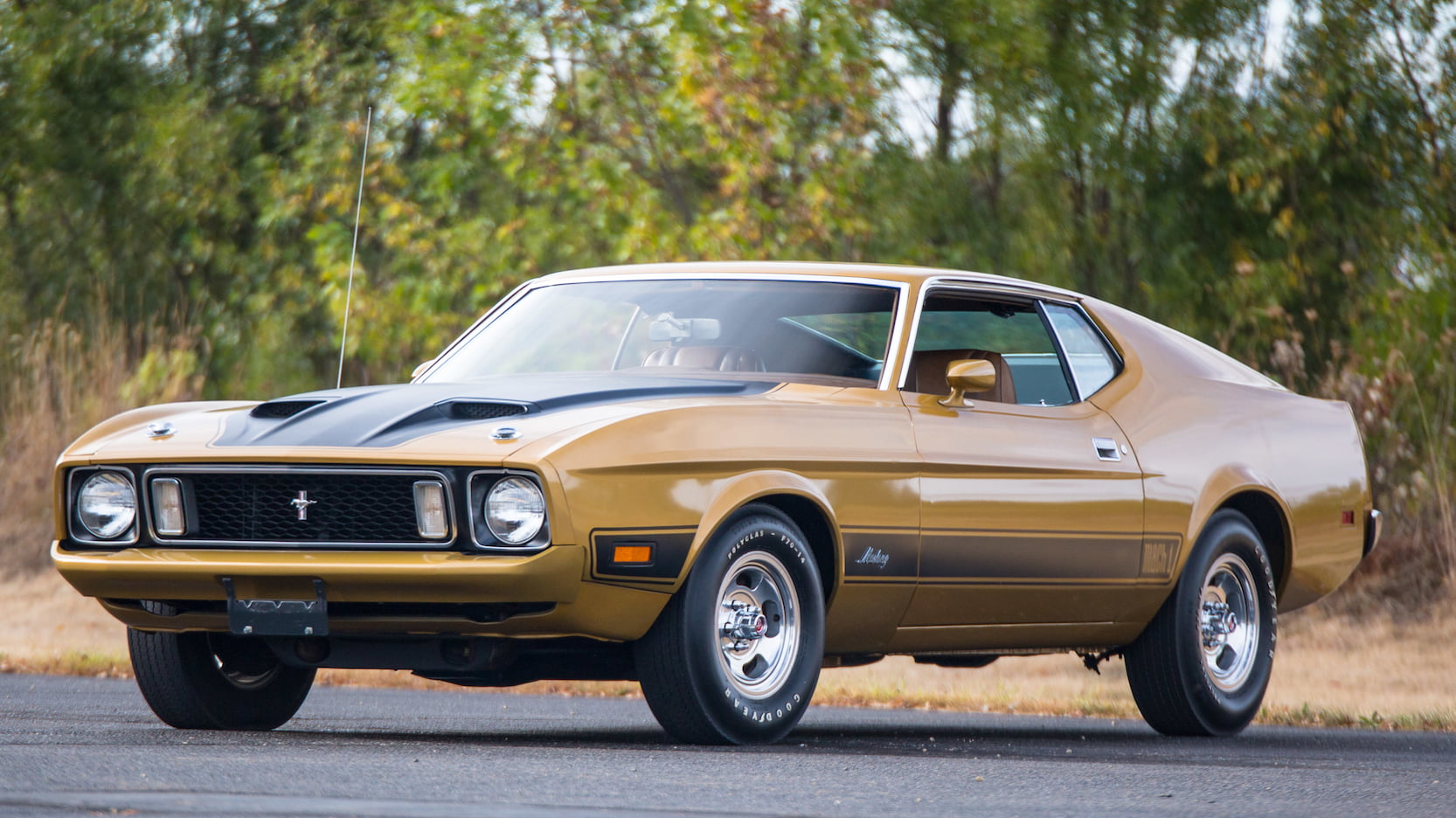
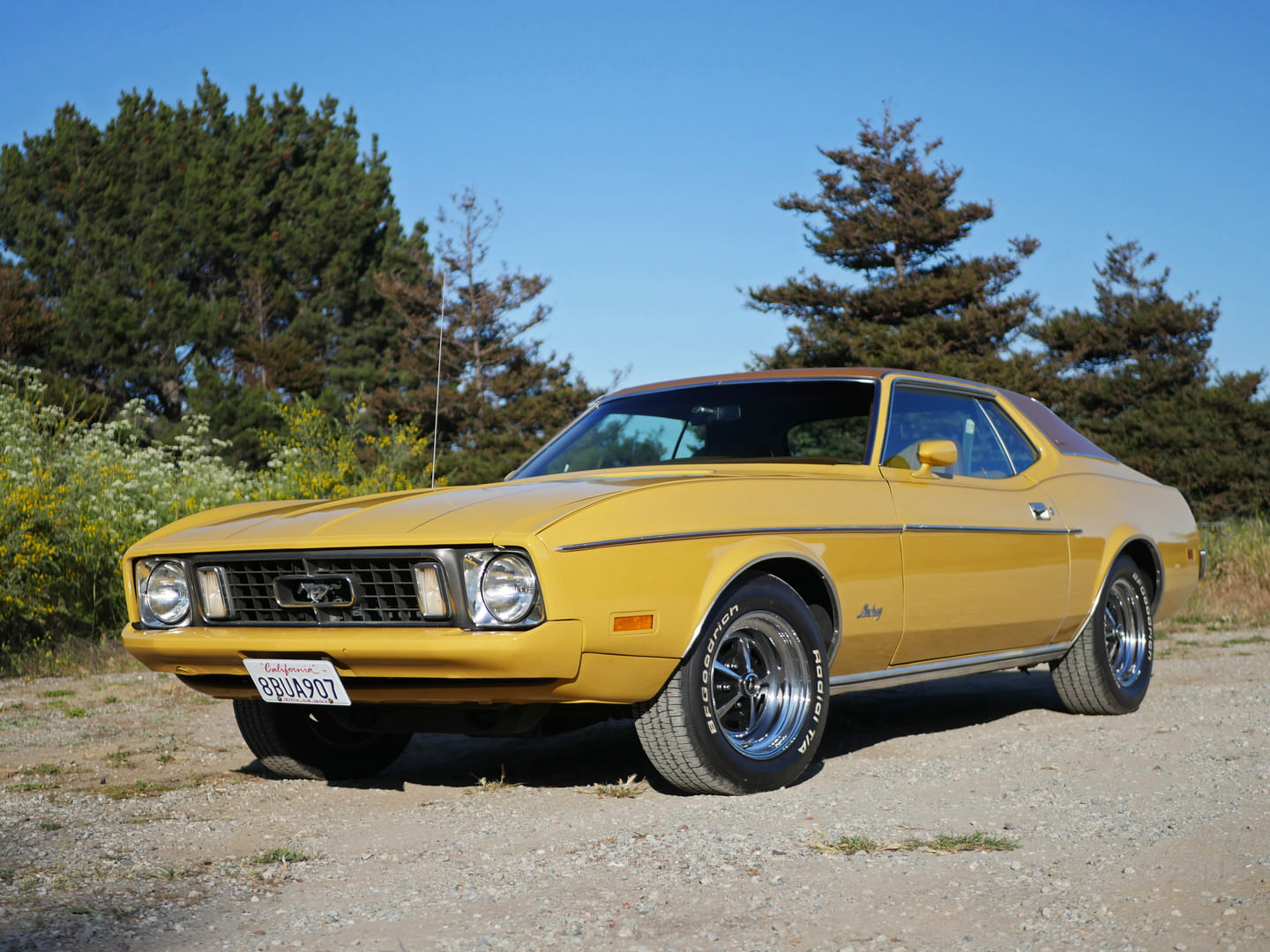
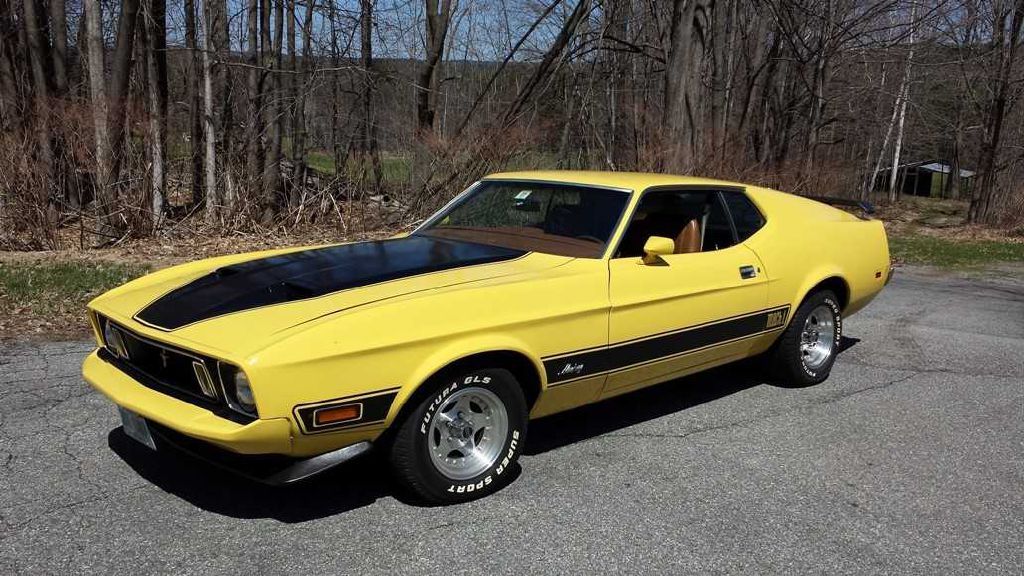
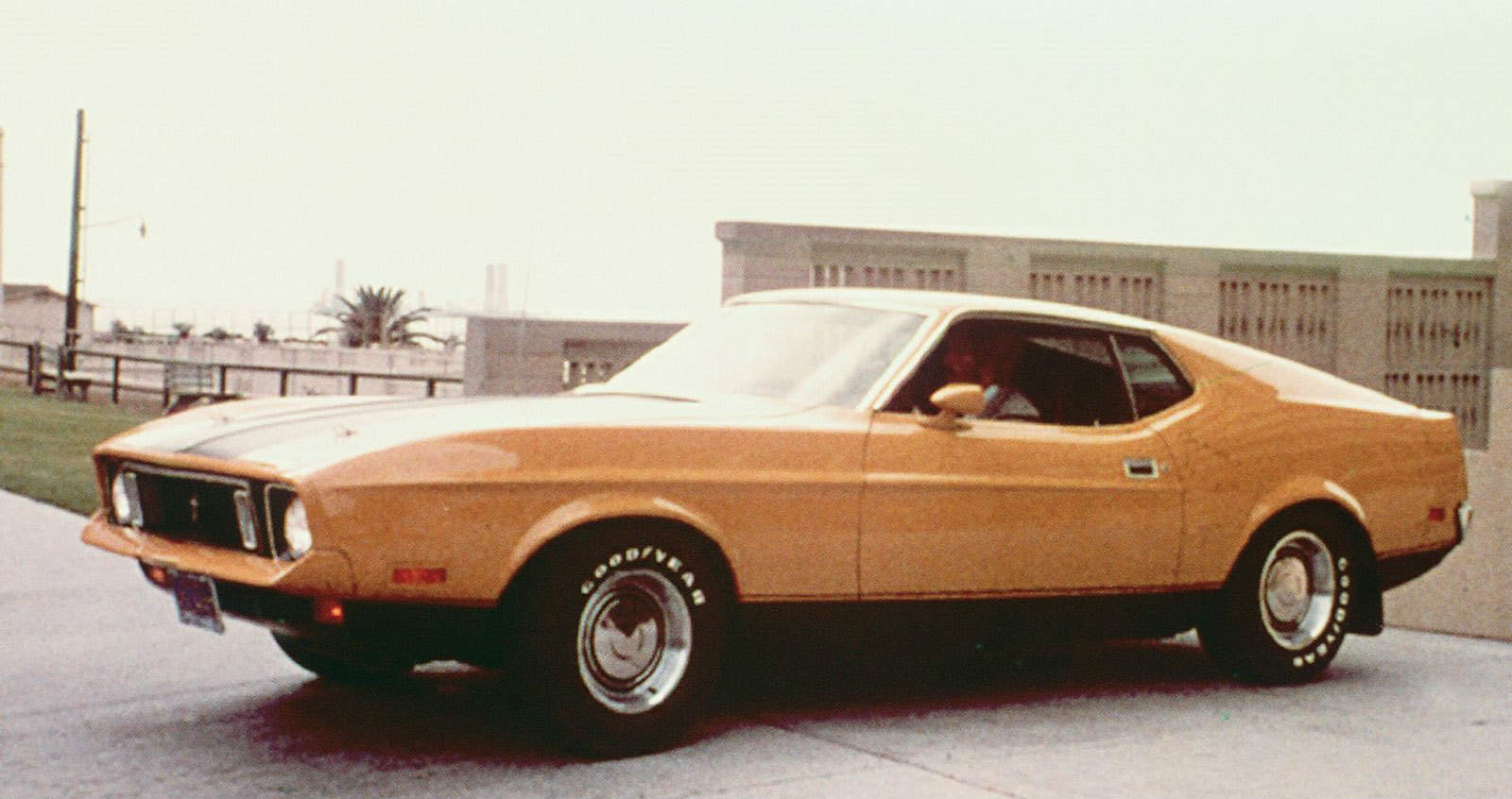
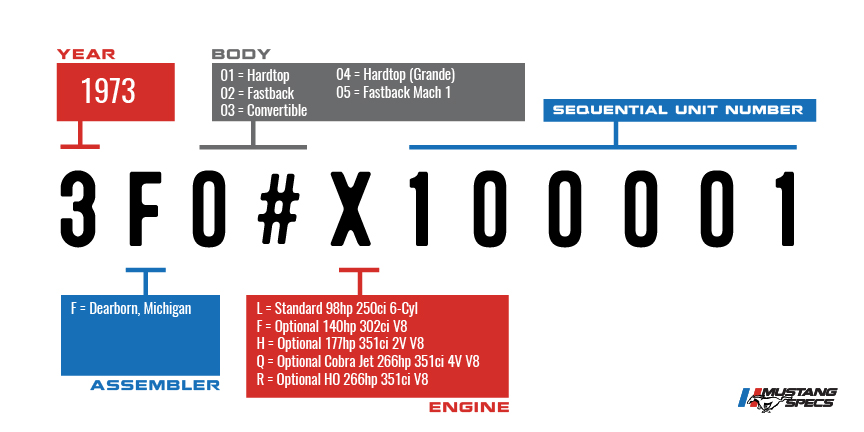


Hello – I am feeling nostalgic for a 1973 Mustang Mach 1 that I custom ordered when I was 17 in the winter of 1972/73. I sold it in 1975 to pay my for college. It was Medium Brown (Ginger), Cleveland 4barrel with a Hurst 4 speed. The interior was white. I ordered the Black Nasa hood with hood pins. I had the 3/4 Black Vinyl top and a rear deck spoiler. The car was ordered with 8 track tape but actually came with the AM/FM radio (maybe they quit making them with 8 tracks back then). I am thinking this combination of options make it a bit unique. I am frustrated that I did not save the documentation (VIN Number). I ordered it from my local Ford dealer (Baker Ford back then) in Willmar, Minnesota. I sold the car to a buyer from Montevideo, Minnesota in early 1975 if I recall. I would love to find out if the car is a “survivor” and if it still is out there somewhere.
Yes they still offered and had the 8 track tape in 73 as I had that ordered. My MACH 1 was Blue and sold in 1085. I have a 2013 GT 5.0 and still looking for the older Stangs especially the 73 MACH 1.
Are there production numbers for 73 convertibles with factory Air?
Send your VIN in for a Marti report. http://www.martiauto.com
I don’t have any numbers but I have one of the cars.
I have a 1973 Red convertible with factory air and 351C 2bbl with C6, I’ve had the car since about 1978 and it has nearly 120k miles on it. Unmodified.
Hi I have a 1973 mach1 5T saddle bronze metallic no black painted hood ,no rear spoiler, single axle 9 “ rear, C-6 automatic with the 351 Cleveland 2 barrel, factory Air, am radio, no console or rear fold down interior, ginger deluxe interior with a rare original ginger 3/4 vinyl roof, 58,460 original miles ,bought back in 1985 with a little over 48,000 miles, have shown in judged concourse in many shows and have placed from 1st to third at almost all shows, runs drives like new , 1/4 mile times on Jetton revenged 14 inch tires, running to 5,000 rpms without hesitation, 16.56 et. At around 88 -89 mph.also has original aluminum Ford slots and Deluxe rear bumper and guards, all other Mach 1 striping and interior gauge package including in dash Tach, 9- out of 10 car, just like it rolled out the line wire for wire ,part for Part, I love the ginger interior and the saddle Bronze outside color, all original except one repaint since new. Love Mustangs All.
I purchased a 1973 Grande just like the one in this article on Feb 2021 351 Q code C6
p disc brake- p steering- power windows -console- convenience group- tinted glass
am radio- tilt steering- instrumentation group- traction loc diff- extra coll pack
competition suspension- gr 78 x 14 radial wsw- deluxe seat belts- protection group rear bumper guards had been sitting in a garage since 1979 one owner with quarter inch of dust. Massaged it back to life compounded the paint looks almost new and
drives like new with 14360 miles.
I have a ’73 convertible. Original colour was pink. I have just started a complete rebuild on the car and will be rebuilding it to be a weekend driver (not a complete return to stock but close).